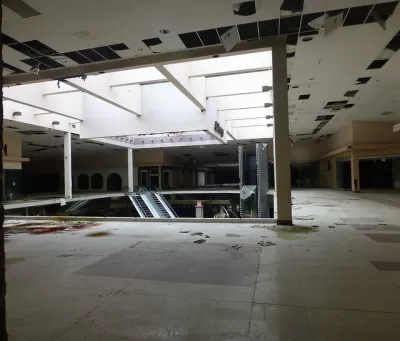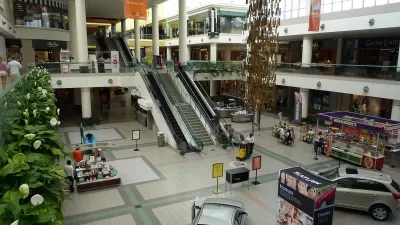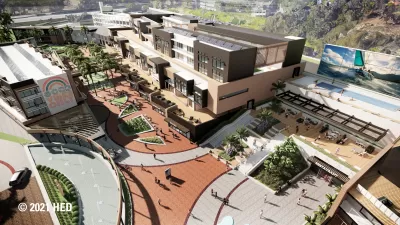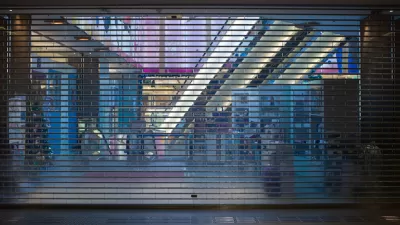Local leaders in Virginia are banking on mall redevelopment projects to revive their tax bases and create more mixed-use neighborhoods.

With traditional retail tax bases such as malls losing popularity, cities have to contend with the question of what to do with the buildings and spaces left behind. In Virginia, some city leaders are "grasping for ways to retrofit forgotten malls for urban living" in an effort to urbanize the suburbs and revitalize slumping neighborhoods. Writing in the Virginia Mercury, Wyatt Gordon reports on how cities and counties are responding to the shift in demand for commercial real estate.
Henrico County director of planning Joe Emerson says his county is working to make redevelopment of malls easier through "reworking our form-based code to put the flexibility in place for the private sector to come in and redevelop these indoor malls." To encourage redevelopment at the site of the former Regency Square Mall, "the county paid for infrastructure and roadway upgrades to incentivize the recycling of existing commercial spaces, the addition of residential units and the construction of a new sports facility to anchor the development." Emerson says "people still want that suburban lifestyle, but people also want mixed-use communities." Since malls are often situated in prime locations along busy commuter corridors, county officials hope that they will serve as ideal locations for multi-modal transit hubs.
In many cases, "redevelopment rather than retrofitting is the best way to deal with dead and dying malls. "The fantasy that a mall will be converted to a new use doesn’t often pencil out for developers," says Daniel Herriges, senior editor at Strong Towns. "These single-purpose buildings weren’t built to last 100 years in the first place so many older malls lack exterior windows and have structural problems too. It’s way cheaper to demolish the whole thing and start anew."
Herriges also warns against cosmetic changes that don't truly enhance livability or access. "Many of these retrofitted communities have the outward aesthetics of New Urbanism but are flawed in the way the community actually works and is structured. City planning offices often get shiny object syndrome — they focus all of their energy on one golden goose and ignore all the incremental changes they could make to increase prosperity across the whole locality."

Manufactured Crisis: Losing the Nation’s Largest Source of Unsubsidized Affordable Housing
Manufactured housing communities have long been an affordable housing option for millions of people living in the U.S., but that affordability is disappearing rapidly. How did we get here?

Americans May Be Stuck — But Why?
Americans are moving a lot less than they once did, and that is a problem. While Yoni Applebaum, in his highly-publicized article Stuck, gets the reasons badly wrong, it's still important to ask: why are we moving so much less than before?

Using Old Oil and Gas Wells for Green Energy Storage
Penn State researchers have found that repurposing abandoned oil and gas wells for geothermal-assisted compressed-air energy storage can boost efficiency, reduce environmental risks, and support clean energy and job transitions.

Updating LA’s Tree Rules Could Bring More Shade to Underserved Neighborhoods
A new USC study finds that relaxing Los Angeles’ outdated tree planting guidelines could significantly expand urban tree canopy and reduce shade disparities in lower-income neighborhoods, though infrastructure investments are also needed.

California's Canal Solar Projects Aim to Conserve Resources and Expand Clean Energy
California’s Project Nexus has begun generating electricity from solar panels installed over irrigation canals, with researchers and state agencies exploring statewide expansion to conserve water and boost clean energy production.

HHS Staff Cuts Gut Energy Assistance Program
The full staff of a federal program that distributes heating and cooling assistance for low-income families was laid off, jeopardizing the program’s operations.
Urban Design for Planners 1: Software Tools
This six-course series explores essential urban design concepts using open source software and equips planners with the tools they need to participate fully in the urban design process.
Planning for Universal Design
Learn the tools for implementing Universal Design in planning regulations.
Heyer Gruel & Associates PA
City of Moreno Valley
Institute for Housing and Urban Development Studies (IHS)
City of Grandview
Harvard GSD Executive Education
Salt Lake City
NYU Wagner Graduate School of Public Service
City of Cambridge, Maryland





























